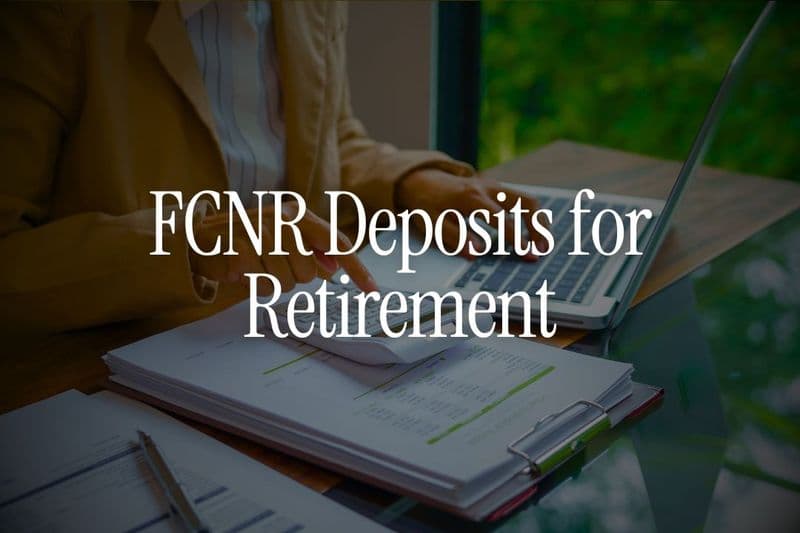
A client in Abu Dhabi recently asked me a question I hear often: "Ankur, I have $150,000 saved. Should I park it in FCNR deposits for my retirement?"
My answer wasn't a simple yes or no. It depends on your timeline, risk appetite, and where you plan to retire. Let me break this down honestly.
What Is an FCNR Deposit?
FCNR (Foreign Currency Non-Resident) is a fixed deposit where you park foreign currency-USD, GBP, EUR, AUD, CAD, or JPY-in an Indian bank. Your money stays in that currency throughout the tenure (1-5 years).
The key attraction? Tax-free interest in India and zero currency conversion risk. Both principal and interest are fully repatriable.
The Case FOR Using FCNR for Retirement
Currency protection matters when you're abroad. If you're earning in USD and plan to retire in the US, UK, or UAE, FCNR keeps your money in dollars. No rupee depreciation eating into your corpus.
The INR has depreciated roughly 3-4% annually against the USD over the past decade. A ₹1 crore NRE fixed deposit in 2015 would have lost significant value in dollar terms by 2025.
Tax efficiency is real. Interest earned on FCNR deposits is completely exempt from Indian income tax under Section 10(4)(ii). Compare this to NRO accounts where TDS is 30%.
Safety and predictability. FCNR deposits are backed by RBI-regulated banks. Deposits up to ₹5 lakh are insured by DICGC. For risk-averse retirees, this matters.
👉 Tip: FCNR works best if you're certain you'll retire outside India. The currency protection becomes your biggest asset.
Also Read -NRE vs NRO vs FCNR
The Case AGAINST Using FCNR for Retirement
Returns are modest.
Current USD FCNR rates range from 3.5% to 5% annually. Some banks like Tamilnad Mercantile offer up to 5.5% for 1-year USD deposits, but most hover around 4%.
Compare this to Indian rupee FDs offering 6.5-7.5% or GIFT City USD FDs offering 5-6% with similar tax benefits.
Maximum 5-year lock-in creates gaps.
Retirement planning spans 20-30 years. FCNR's maximum tenure of 5 years means you'll keep renewing at whatever rates prevail. No long-term rate lock.
Premature withdrawal hurts.
Premature withdrawal hurts. If you withdraw before one year, you get zero interest. After one year, banks typically pay interest at the rate applicable for the period the deposit was held, with no penalty or a reduced rate (varies by bank; many apply no additional penalty).
Opportunity cost is significant. Parking $150,000 in FCNR at 4% gives you $6,000 annually. The same amount in diversified mutual funds or GIFT City AIFs could potentially yield more over decades.
FCNR vs Other Retirement Options: Quick Comparison
Feature | FCNR Deposit | NRE FD | GIFT City USD FD | Mutual Funds |
|---|---|---|---|---|
Currency | USD/GBP/EUR | INR | USD | INR |
Returns (approx.) | 3.5-5% | 6.5-7.5% | 4.5-6% | 10-12% (equity) |
Tax in India | Exempt | Exempt | Exempt | Applicable |
Currency Risk | None | High | None | High |
Liquidity | Low (1-5 yr lock) | Medium | Low | High |
Max Tenure | 5 years | 10 years | Varies | No limit |
👉 Tip: Don't put all your retirement eggs in one basket. FCNR can be one component, not your entire strategy.
Also Read - Top Banks Offering the Highest FCNR Deposit Rates
When FCNR Makes Sense for Retirement
FCNR deposits work well in specific situations:
You're retiring outside India.
If Dubai, London, or New York is your permanent home, keeping money in your earning currency avoids conversion losses.
You need a stable, guaranteed portion.
Allocating 20-30% of your retirement corpus to FCNR gives you a predictable safety net while the rest grows in equities or alternative investments.
You're within 5 years of retirement.
Short-term parking in FCNR protects your corpus from market volatility right before you need it.
You want to use it as loan collateral.
Most banks offer loans up to 70%-90% of FCNR deposit value. Useful for emergencies without breaking the deposit.
When FCNR Is a Bad Idea
You're planning to return to India. Once you become a resident, FCNR interest becomes taxable. You'll also need to convert to RFC (Resident Foreign Currency) account, adding complexity.
Your retirement is 15+ years away. With that time horizon, equity-based investments historically outperform fixed deposits significantly. The safety of FCNR becomes an opportunity cost.
You need regular income. FCNR pays interest annually or at maturity. It's not designed for monthly retirement income needs.
👉 Tip: Use our Residential Status Calculator to understand how your tax status changes upon return. This affects your entire retirement strategy.
A Smarter Approach: The Hybrid Strategy
Based on advising hundreds of NRIs, here's what works:
For the safety portion (30-40%): Split between FCNR and GIFT City USD fixed deposits. GIFT City often offers slightly better rates with similar tax benefits.
For the growth portion (40-50%): Diversified equity mutual funds or GIFT City AIFs for higher returns over longer periods.
For liquidity (10-20%): NRE savings accounts or short-term debt funds you can access quickly.
Use the FD laddering strategy-spread your FCNR deposits across 1, 2, 3, 4, and 5-year tenures. This gives you annual liquidity while maximizing returns.
The Verdict
FCNR deposits aren't bad for retirement-they're just not sufficient alone.
They're excellent for currency protection and capital preservation. But building a retirement corpus purely on 4% returns is risky when inflation and lifestyle costs rise faster.
Think of FCNR as the foundation of your retirement house, not the entire structure. Build on it with growth-oriented investments suited to your timeline.
Comparing FCNR rates across banks?
Use our free NRI FD Comparison Tool to find the best rates instantly.
Questions about retirement planning as an NRI?
Join our WhatsApp community where 5,000+ NRIs discuss investment strategies daily.
Ready to explore better options?
Download the Belong app to access GIFT City investments with tax-free returns.
Also Read - Can NRIs Invest in Government Bonds and Treasury Bills?
Sources:




